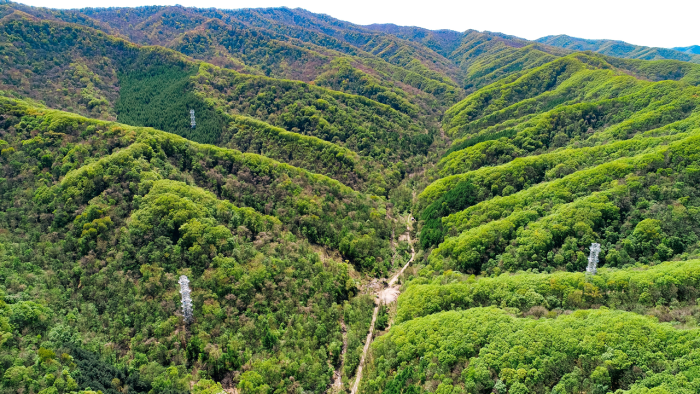




このケーススタディでは、中国科学院清遠森林 CERN 研究所の不均一な地形におけるCO 2 /H 2O微量ガスフラックスを測定する理論と技術を探すためにCPEC310およびAP200システムを統合する方法について説明します。
CPEC310 (閉路渦相関システム) と AP200 (大気プロファイル システム) は、微気象センサー、硝酸塩関連の微量ガス分析装置、土壌表面 CO 2フラックス システムとともに、中国科学院清遠森林 CERN フィールド研究所における森林生態学と管理に関する研究を促進する 3 つの高さ 50 メートルのタワーに統合されています (図 1)。 (CERN は中国生態学研究ネットワークです。) Campbell Scientific の CPEC および AP システムの新しい開発を活用した統合システム ネットワークは、山岳森林 (つまり、不均質な景観) 上の CO 2 /H 2 O/微量ガス フラックスを測定する理論と技術を研究するための最先端の設計です。これは、中国北東部で最も一般的な 3 種類の森林 (天然の混合広葉樹落葉樹林、天然のモンゴルナラ林、カラマツの植林林) に覆われた清遠森林 CERN 流域のフラックスの長期データを収集しながら行われます。
清遠の森 CERN CAS
清遠森林 CERN は中国科学院 (CAS) が直接支援するフィールド研究所で、主に中国科学院応用生態研究所 (IAE) が管理しています。林業の生態学者、気象学者、水文学者の間での国際的な共同研究が可能です。Jiaojun Zhu 博士は清遠森林 CERN の所長であり、CAS IAE の所長も務めています。ほとんどのケース (例えば、不均質な景観上の山岳林、図 1) を代表するフィールド森林での研究哲学を持つ同博士は、天然の混合広葉樹林、天然のオーク林、植林されたカラマツ林で覆われた山の流域を清遠森林 CERN の実践フィールドとして選びました。2003 年、同博士はこのフィールド研究所を、森林の生態学と管理、およびその結果生じる環境への影響に関する主要なプロジェクトに十分対応できる包括的なものとして設計し、設立しました。これらのプロジェクトは、中国国家科学基金、CAS、および中国科学技術委員会によって資金提供されています。現在、ここでは年間数百万ドルの支援を受けている数十のプロジェクトが進行中です。人間の撹乱による森林の成長と発達の影響を受けた森林生態系と大気の間の CO 2 /H 2 O および窒素関連微量ガスの交換(つまり、森林上のフラックス)を定量化する長期的で質の高いデータは、この研究室にとって不可欠です(Zhu et al. 2018)。
CPEC310およびAP200システムと他のセンサーの統合
不均質な景観に広がる清遠森林 CERN の山林分野では、均質な景観に一般的に適用されるフラックス測定技術が理論的に課題となっています。清遠森林 CERN の主な目的は、品質を保ちながら可能な限り時系列で連続したデータを要求することであり、フラックス測定機器システムの品質と機能性も機器的に課題となっています。3 つのタワーでは、両方の課題を解決するために、最先端の主要コンポーネントとして CPEC310 と AP200 を統合するという選択がなされました。また、研究グレードのミクロ気象センサー、さまざまな気象条件に耐える硝酸塩関連の微量ガス分析装置、システム制御とデータ共有において CPEC310 および AP200 と互換性のある土壌 CO2 フラックス システムも選択されました。
CPEC310
CPEC310 は、キャンベルサイエンティフィック社が新たにリリースした CPEC システムです (図 2a および 2c)。その CO 2 /H 2 O フラックス測定は、オープンパス渦共分散 (OPEC) システムによる同じ測定を評価するために使用されるベンチマークです (Helbig 他 2016)。他の CPEC システムと比較して、4.2 Hz のカットオフ周波数の高速応答 (Ma 他 2017)、消費電力の低減、さまざまな気象条件での一貫したパフォーマンス (Novick 他 2013) を備えています。OPEC の同等製品と比較して、熱平衡設計により、測定された空気流の温度と圧力をより正確に、より正確に同期して測定します。これにより、WPL 補正のために圧力が静的であると想定される OPEC システム (Webb ら 1980、Zhang ら 2011) で発生する測定誤差が回避され、高周波 (例: 10 Hz) での CO 2 /H 2 O 信号に対する分光効果の補正のための温度が、従来の低速センサー (例: モデル 107 プローブ、Wang ら 2016b) を使用して測定されます。
さらに重要なことに、CPEC310 には 2 つの際立った利点があります。
- ユーザー定義の時間間隔で設定される自動ゼロ/スパン機能。この機能は、CO 2 /H 2 O 分析装置 (LI-COR Biosciences 2016) の作業方程式のゼロおよびスパン パラメータを定期的に (ユーザー設定を介して) 調整し、システムの実行温度に合わせます。これにより、CO2/H2Oフラックスの測定精度が技術的に向上します。
- EasyFlux-DL-CR6CP ソフトウェア。このソフトウェアは、フラックス コミュニティが採用した仕様に従ってデータを処理しながら、測定と自動ゼロ/スパンを制御および操作します。
AP200
Campbell Scientific 社製の AP200 (図 2b および 2d) は、最大 8 つの高度レベルで CO 2 /H 2 O、気温、相対湿度を測定する大気プロファイル システムで、その垂直分布はユーザーが設定できます。このシステムは、渦共分散システムと組み合わせて使用されることがよくあります。このシステムでは、CPEC310 と統合されています。CPEC310 でフラックス計算に使用される平均間隔にわたって、さまざまなレベルのデータを使用して、CPEC310 レベル (つまり、制御ボリューム) までのプロファイル上の CO 2 /H 2 O と生物圏と大気間の蓄熱の個々の変化を計算します。この変化は、制御ボリューム内の蓄熱の増減であるため、蓄熱項と呼ばれます。これらの項の量は、境界層の成層と種の構成、植生の表面密度と体積密度、およびそれらのキャノピー内の空間分布との相互作用によって異なります。したがって、フラックス計算では、高速応答プロファイル システムに基づくこれらの貯留期間と CPEC310 で測定されたフラックスを統合することで、フラックスおよび純生態系交換の推定の信頼性を大幅に向上させることができます (NEE、Wang 他 2016a)。これは、貯留期間測定の方法論をシステム インフラストラクチャに標準化するために、最近国際炭素観測システムによって提唱されました (Montagnani 他 2018)。
CPEC310 と同様に、AP200 にも 2 つの際立った利点があります。
- オートゼロ/スパン機能
- EasyFlux-DL-CR1KXAP ソフトウェア (開発中)
ソフトウェアは適応性が高く、このケース スタディでは、カップ風速計 (モデル: 010C、Met One Instrument、オレゴン州) の垂直プロファイルと土壌水分および温度測定 (モデル: CS655、TCAV、Campbell Scientific、ユタ州) に対応するように変更されました。これらの追加により、AP200 は包括的な分析のためにより多くの対象変数を測定できるようになります。
微気象センサー
各タワーには以下のセンサーが装備されていました。CNR4 4 成分放射計 (Kipp & Zonen、アムステルダム) は、森林の樹冠への入射および出射放射 (長波および短波) を測定します (図 3a)。HFP01SC 自己較正土壌熱流束プレート (Hukseflux Thermal Sensors、デルフト)、TCAV、および CS655 の 3 つの複製は、土壌熱流束、土壌水分および温度プロファイルを測定します (1 つの複製については図 3b)。SI-111 赤外線放射計は、樹冠の内側 (図 3d2) と外側 (図 3d1) の表面温度を測定します。52202 雨量計 (RM Young Company、ミシガン州) は、降水量を測定します (図 3c)。
土壌CO2フラックスシステムと微量ガスフラックスシステム
各タワーには以下のセンサーが装備されています。森林床からの CO2 流出量を測定するために、システム制御およびデータ共有において CPEC310 および AP200 と互換性のある土壌表面 CO2フラックスシステムが設計されており、窒素関連の微量ガスのフラックスを測定するために微量ガス分析 (TGA) (Campbell Scientific、UT) が予定されています。微量ガス フラックスは、3 種類の森林における栄養循環と、農業生態系と森林生態系間の環境相互作用を調べるために使用されます。
完全なオプション、研究グレード、統合
3 つのタワーに設置されたすべてのシステムには、利用可能な場合はフル オプションが選択されました。CPEC310 には、自動ゼロ/スパンで最高のパフォーマンスを発揮するバルブ モジュールとスクラブ モジュールのオプションがあります。AP200 には、最も信頼性の高い測定のために、ゼロ ガス ボトルと最大数のサンプリング インテークのオプションがあります。CNR4 には、夕方、風が弱く、湿気の多い状況でより優れたデータを取得するための CNF4 オプションがあります。52202 雨量計には、冬季のデータ可用性のために加熱アクセサリのオプションがあります。
3 つのタワーに設置されているすべてのセンサーは、生態学の研究グレードです。CNR4 は高性能の 4 成分放射計です。HFP01SC は森林用の自己較正機能を備えた唯一の土壌熱流束プレートです。52202 雨量計はタワーに取り付けるのに最適な選択肢です。
すべての測定システムとセンサーは、システム全体に統合されています。CPEC310 からのデータは、AP200、土壌表面 CO2 フラックス システム、トレース ガス システムによってオンラインで共有され、最終的には生態系レベルの変数の値 (NEE など) を計算するように設計されています。この計算は、AP200 の CR1000X データロガーによって要約できます。要約は、森林の生態学と管理に関するほとんどの研究トピックに使用できるほど堅牢なコア データ ファイルになります。
挑戦、優位性、展望
フラックス測定および関連研究にとって、不均一な地形に広がるCERN清遠森林の山林は課題が多く、CPEC310とAP200を他の高品質センサーと統合した最先端の設計が有利です。この課題に立ち向かい、この利点を活用するために、CAS-CSI森林微量ガスおよび同位体元素フラックス監視研究開発共同研究所(Ker共同研究所)(図4)が設立されました。この研究所は、応用生態学研究所、CAS傘下の他の研究所、Campbell Scientific、Campbell Scientific(北京)カンパニーリミテッド、瀋陽農業大学、東北林業大学、北京テクノソリューションズリミテッド、および海外からの訪問科学者をチームとして組織しています(図4b)。
このチームは長期データを収集しながら、主に次の3つのタスクに焦点を当てています。(1)3種類の山岳森林上のCO 2 /H 2 O及び窒素関連ガスのフラックスを測定するための理論と技術の開発、(2)修士・博士課程の候補者及びポスドク研究員に対する研究教育、(3)Campbell ScientificのCO 2 /H 2 Oおよび微量ガスフラックスシステムの新開発の応用。
チームは、(1)生態系規模で3種類の森林が別々に及ぼすフラックスと環境に関する長期データを提供し、清遠森林研究センターCERNで実施されるすべての研究プロジェクトをサポートする、(2)不均質な景観における大気成分のフラックスを測定するための理論と技術を改善する、(3)中国のフラックスコミュニティに、CERNの将来のフラックス測定システムの更新に最適な選択肢としてCPEC310とAP200の統合を実証する、という3つの視点を提示します。
寄稿者情報
- 寧鄭:Campbell Scientific(北京)有限公司、CAS-CSI 森林微量ガスおよび同位元素フラックス監視研究開発共同研究所(Ker 共同研究所)
- エミリー・フー:Campbell Scientific(北京)カンパニーリミテッド
- 田高:清遠森林 CERN、中国科学院応用生態研究所、中国科学院-中国科学院微量ガスおよび同位元素の森林フラックス監視研究開発共同研究所(Ker 共同研究所)
- 馮源于:清遠森林 CERN、中国科学院応用生態学研究所、中国科学院-中国科学院微量ガスおよび同位元素の森林フラックス監視研究開発共同研究所(Ker 共同研究所)
参考文献
Helbig, M, K Wischnewski, GH Gosselin, SC Biraud, I Bogoev, WS Chan, ES Euskirchen, AJ Glenn, PM Marsh, WL Quinton, O Sonnentag. 2016. EC150 および IRGASON オープンパスガス分析装置による二酸化炭素フラックス測定における系統的バイアスへの対処。Agr For Meteorol 228-229: 349-359。
LI-COR Biosciences. 2016. LI-7500RS オープンパス CO 2 /H 2 O ガス分析装置: 取扱説明書。リンカーン、NE。p. 4-1 ~ 4-11 および 8-1 ~ 8-9。
Ma, JY, TS Zha, X Jia, S Sargent, R Burgon, CA Bourque, XH Zhou, WJ Chen, YJ Bai, P Liu, YJ Wu. 2017.生態系の二酸化炭素と水のフラックスを測定するための渦取入口を備えた革新的な渦共分散システム。Atmos Meas Tech 10: 1259-1267。
Montagnani, L, T Crűnwald, A Kowalski, I Mammarella, L Merbold, S Metzger, P Sedlák, L Siebicke. 2018.渦共分散測定における貯蔵期間の推定:ICOS方法論。International Agrophysics 32: 551-567。
Novick, KA, J Walker, WS Chan, A Schmidt, C Sobek, JM Vose. 2013. 新しい高速応答密閉パス分析装置による渦共分散測定: スペクトル特性とシステム間比較。Agr For Meteorol 181: 17-32。
Wang, X, C Wang, Q Guo, J Wang. 2016a.背が高く密な樹冠の温帯林における単一プロファイルシステムによる CO2 貯留測定の改善。Agr For Meteorol 228: 327-338 。
Wang, W, JP Xu, YQ Gao, I Bogoev, J Cui, LC Deng, C Hu, C Liu, SD Liu, J Shen, XM Sun, W Xiao, GF Yuan, XH Lee. 2016b. 寒冷砂漠環境における統合オープンパス渦共分散システムの性能評価。J Atmos Oceanic Techn 33: 2385-2399。
Webb, EK, GI Pearman, R Leuning. 1980. 熱と水蒸気の移動による密度効果に対するフラックス測定の補正。QJ Royal Mete Soc 106: 85-100。
Zhang, JH, XH Lee, GZ Song, SJ Han. 2011. 二酸化炭素フラックスの長期測定に対する圧力補正。Agr For Meteorol 151: 70-77。
Zhu JJ、QL Yan、LZ Yu、JX Zhang、K Yang、T Gao。2018。森林生態学の研究と実証に基づく中国東北部の森林の生態学的回復と持続可能な管理の支援。中国科学院紀要、33:107-118。
ケーススタディの概要
アプリケーション
山岳森林(不均質な景観)におけるフラックス研究場所
中国北東部使用製品
CPEC310 CS655 AP200 CNR4-L 52202-L SI-111 TCAV-L HFP01SC-L寄稿者
Ning Zheng, Emily Fu, Tian Gao, Fengyuan Yu参加団体
清遠森林 CERN、中国科学院、ケル共同研究所計測項目
CO 2、H 2 O、硝酸塩関連微量ガス のフラックス、気温、空気水分、CO 2、風速、土壌水分、土壌温度のプロファイル、CO 2およびH 2 O貯蔵条件、エネルギー条件、純生態系交換参加コンサルタント/インテグレーター
Beijing Techno SolutionsPDFで見る